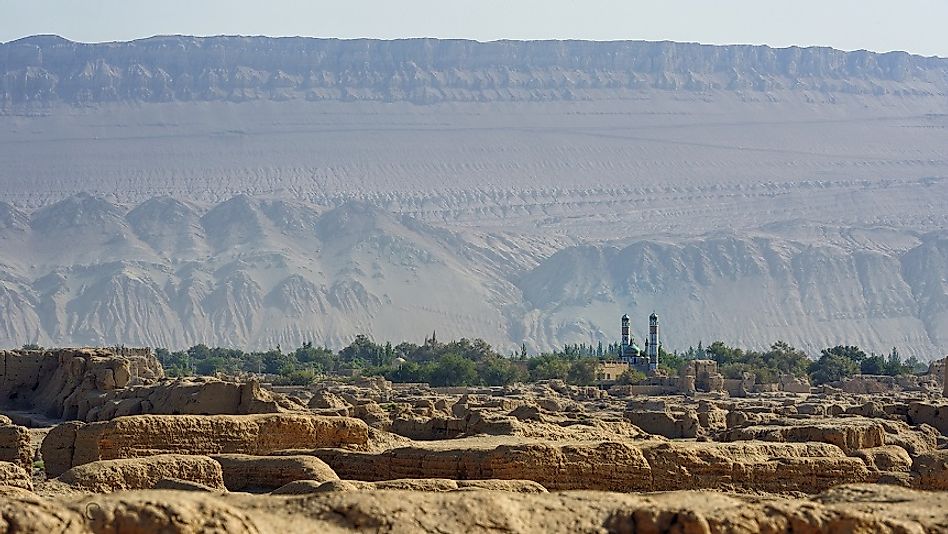Where is the Xinjiang Uyghur Autonomous Region?

The Xinjiang Uyghur Autonomous Region is set apart from the rest of China by its culture and geography. The Han Chinese first settled the region as early as 2,000 years ago and claims the region as part of China. The Uyghur people are Muslims from western China, and have enjoyed autonomy status for short, alternate periods of time since it was annexed by Chinese rule. Xinjiang is about the size of Iran at 642,820 square miles. Today, it has a population of about 21,815,815, comprised mostly of Han Chinese and native Uyghur people, with roughly equal proportions of each. The region has 14 prefectures, 99 counties, and 1,005 towns. Its largest and capital city is Urumqi.
5. Historical Role
Xinjiang was under the protection of the Han Dynasty in 60 BC as part of the Northern Silk Road route. The years after and before were alternately ruled by the Manchus and Mongols. During the Qing Dynasty, after Zhunbu and the Tarim Basin were merged, it was given that name in 1844. Xinjiang means "An old frontier which returns recently". In 1829, the region was named East Turkestan however in 1955, it was renamed "Xinjiang Uyghur Autonomous Region." Separatist and extremist mentalities have been seen as of late in the recent bombings in Beijing, and some Uyghurs being detained by Americans. The natural resources of the region, such as oil and gas, have been denied to the native Uyghurs, resulting in discontent and outcries.
4. Economic Significance
Historically, Xinjiang has had an agricultural economy, and also mined jades for its early agricultural dynasties. Oil, gas, and minerals are some of its most important resources today. Its agricultural lands are irrigated producing rice, maize, wheat, and millet. Cotton is still being planted which started in the 19th Century. It also has a diverse produce such as fruits and nuts. Its northern area has sheep and livestock. Xinjiang is landlocked but its fishponds, lakes and rivers produce enough fish for its local consumption. Other resources include soda, borax, salt, gold, coal, and jade. Economic zones, export processing zone, economic cooperation area, and Hi-tech Industrial zones were also established. The HI-tech zone has about 23 companies belonging to the Fortune 500 out of 3,470 companies in that particular zone.
3. Culture, Language, and Religion
Xinjiang culture is a mix of some 19 distinct cultures, with the most prominent therein being the Uyghur, Han, Kazakh, Hui, and Kirghiz. With the implementation of the Chinese economic reform instituted in 1978, the Uyghur numbered at 46% of the populace with the Han Chinese accounting for 40%. Today, these numbers have not changed significantly. The Han are mostly located in the northern area, while the Uyghur are in the southwestern areas. The Han people generally practice Taoism, Buddhism, and Confucianism, while most of the Uyghur and the Hui Chinese are Muslims. Xinjiang has as many languages as ethnicities. The two official languages spoken are Uyghur and Mandarin. Minor languages spoken there, though among far fewer speakers, are Kazakh, Kyrgyz, Oirat,and Mongolian. Besides these languages, there are about 43 lesser languages spoken by diverse peoples working or living in Xinjiang.
2. Habitat and Biodiversity
Xinjiang has deserts, mountains, low valleys, and grassland. It has glaciers, alpine lakes, hot springs, and inland rivers. Its mountain peaks reach over 16,404 feet in height that acts as sentinels to its lakes, basins, ranges, oases, and desert plains. It 22 nature reserves are a testament to its biodiversity. The Przewalski’s wild horse is endemic to its plains and valleys. Its topography features low valleys that are below sea level. Lately, fossils and petroglyphs were discovered in the Altay region of Xinjiang. The area also has 256 protected cultural sites. Its most interesting landscape is dotted with stone forests, echoing sand dunes, ancient grottos, and desert mirages.
1. Territorial Disputes
There is a separatist movement in Xinjiang that is composed of Uyghur people and Muslim Chinese. These people have argued that Xinjiang was never part of China but was annexed only in 1949. The Chinese government has stated that historical records show that as early as the Han Dynasty, the area was protected for its location as the northern Silk Road route. The early Qing Dynasty rulers united the two frontier regions of Dzungaria and the Tarim Basin and named it Xinjiang. Western scholars today claim that Urumqi was inhabited early on by the Han and Hui Chinese with a few migrant Uyghur but due to Uyghur migration, people erroneously concluded that the city was originally an Uyghur settlement. The tensions still continue today, with the biggest two factors influencing the discontent being differences in ethnicity and religion, although the Chinese government does not impose religious practice restrictions on its population today.











